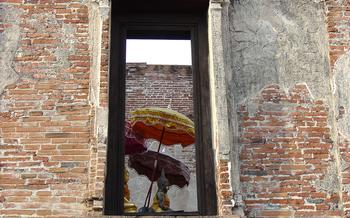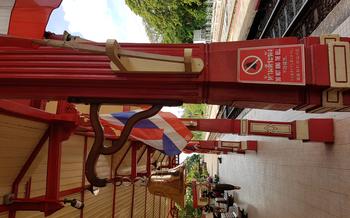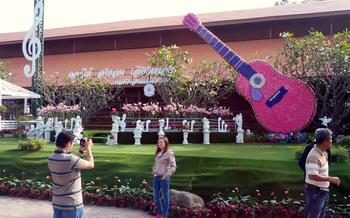
Ban Chang Nak Elephant Wood Carving Art Museum
- A Journey into Exquisite Craftsmanship:
- A Living Legacy: The Art of Elephant Wood Carving
- Master Craftsmen at Work
- A Symphony of Shapes and Textures
- A Touch of Royalty: The Royal Elephant Wood Carvings
- Elephant Wood Carvings as Cultural Ambassadors
- A Treasure Trove of Elephant Wood Carvings:
- Stories Carved in Wood: The Narratives Behind the Carvings
- Interactive Exhibits and Workshops
- A Place of Inspiration and Creativity
- A Journey Through Time: Historical Context of the Museum
- Local Artisans and Their Livelihoods
- Museum Hours, Admission Fees, and Facilities:
- Getting to the Museum: Transportation and Directions
- Insider Tip: Discovering Hidden Gems
A Journey into Exquisite Craftsmanship:
Nestled amidst the serene landscapes of Lampang, Thailand, the Ban Chang Nak Elephant Wood Carving Art Museum stands as a testament to the rich cultural heritage and exquisite craftsmanship of the region. Founded in 1992, the museum is dedicated to preserving and promoting the ancient art of elephant wood carving, a skill that has been passed down through generations in Thailand and holds great significance in the country's cultural identity.
Wood carving has a long and illustrious history in Thailand, dating back to the Sukhothai period (1238-1438). During this time, wood carving flourished as a form of artistic expression, particularly in the creation of intricate temple decorations and religious icons. The art of elephant wood carving gained prominence during the Ayutthaya period (1350-1767), where it became an integral part of royal ceremonies and processions. Elephants, revered creatures in Thai culture, were often depicted in wood carvings as symbols of strength, wisdom, and royalty.
The Ban Chang Nak Elephant Wood Carving Art Museum plays a crucial role in preserving this traditional art form by showcasing a diverse collection of elephant wood carvings from various eras and styles. Through its exhibits, workshops, and educational programs, the museum aims to promote cultural tourism and raise awareness about the importance of preserving this unique craft. By supporting local elephant wood carvers and providing them with a platform to showcase their skills, the museum contributes significantly to the local economy and helps sustain this centuries-old tradition.
A Living Legacy: The Art of Elephant Wood Carving
Elephant wood carving holds a profound place in the cultural heritage of Thailand and neighboring regions. This art form, with its intricate carvings depicting elephants, has been practiced for centuries, passing down skills and techniques from generation to generation. The elephants themselves, revered and cherished in Thai culture, are often portrayed in these carvings as symbols of strength, wisdom, and royalty.
The motifs and designs that adorn these carvings are deeply rooted in Thai mythology, folklore, and history. Elephants are often depicted in scenes from the Ramayana, a revered epic tale, or engaged in various activities such as bathing, playing, or participating in royal processions. The intricate details and lifelike expressions captured in these carvings reflect the deep connection between elephants and Thai society.
The uniqueness of elephant wood carvings lies in their intricate designs, symbolism, and the skill required to create them. Each piece is a testament to the patience, precision, and artistry of the carvers, who meticulously transform ordinary pieces of wood into breathtaking masterpieces. These carvings are not merely decorative objects but rather tangible expressions of Thai culture and identity.
Master Craftsmen at Work
In the heart of the Ban Chang Nak Elephant Wood Carving Art Museum, skilled craftsmen perpetuate a legacy that spans generations. Their hands, guided by intricate knowledge and unwavering patience, transform ordinary wood into extraordinary works of art, preserving the essence of Thailand's rich cultural heritage.
These master craftsmen, inheritors of ancestral techniques, meticulously shape and sculpt each piece, breathing life into inanimate wood. Using traditional tools that have stood the test of time, they delicately carve intricate patterns and motifs, capturing the essence of elephants and other symbols of Thai culture.
The process demands meticulous attention to detail, as even the slightest error can mar the final product. Each stroke of the chisel, each curve of the wood, is carefully executed, reflecting the craftsman's deep understanding of form and proportion.
Visitors to the museum are offered a unique opportunity to witness these master craftsmen at work, as they demonstrate their skills in live workshops and demonstrations. These sessions provide an intimate Einblick into the creative process, allowing visitors to appreciate the dedication and artistry that goes into each masterpiece.
A Symphony of Shapes and Textures
The finished elephant wood carvings are a testament to the skill and artistry of their creators. The diverse range of products includes intricate figurines, delicate wall panels, and even majestic furniture pieces. Each carving is unique, showcasing the natural beauty of the wood and the three-dimensional forms that emerge from it. The vibrant colors and textures of the wood, often left in its natural state, add to the aesthetic appeal of these masterpieces. The interplay of light and shadow further enhances the visual experience, creating a sense of depth and dimension. Handling and admiring the finished carvings is a tactile experience that allows visitors to fully appreciate the craftsmanship and artistry that went into their creation.
A Touch of Royalty: The Royal Elephant Wood Carvings
The history and significance of royal elephant wood carvings in Thailand
Royal elephant wood carvings hold a special place in Thai culture and history. These exquisitely crafted pieces were commissioned by the royal court and used in royal ceremonies, processions, and religious rituals. The carvings often depicted royal symbols, mythological creatures, and scenes from Thai history and folklore.
The intricate designs and motifs used in these carvings, often inspired by royal symbols and mythology
The designs and motifs used in royal elephant wood carvings were often inspired by royal symbols and mythology. Common motifs included the three-headed elephant Erawan, the mythical Garuda bird, and scenes from the Ramayana epic. The carvings were also often adorned with intricate floral and geometric patterns.
The craftsmanship and attention to detail that set royal elephant wood carvings apart
The craftsmanship and attention to detail that went into creating royal elephant wood carvings were unparalleled. The carvers used only the finest quality wood, and each piece was meticulously hand-carved and polished. The resulting carvings were works of art that were both beautiful and durable.
The role of these carvings in royal ceremonies and processions
Royal elephant wood carvings played an important role in royal ceremonies and processions. The carvings were often used to decorate royal elephants, chariots, and palanquins. They were also displayed in royal palaces and temples. The carvings served to add an air of majesty and grandeur to these important events.
Elephant Wood Carvings as Cultural Ambassadors
Elephant wood carvings have transcended the boundaries of Thailand and gained global recognition and appreciation as a unique form of Thai art. The Ban Chang Nak Elephant Wood Carving Art Museum plays a pivotal role in promoting and showcasing this art form internationally. The museum actively participates in exhibitions and cultural exchange programs worldwide, allowing these intricate carvings to captivate audiences beyond Thailand's borders.
Through these exhibitions, the museum introduces international visitors to the rich cultural heritage and symbolism embedded in elephant wood carvings. The museum's participation in cultural exchange programs fosters collaboration and dialogue between Thai artisans and artists from other countries, leading to a cross-pollination of ideas and techniques.
Elephant wood carvings have become cultural ambassadors, representing Thailand's artistic prowess and cultural identity on a global stage. As these carvings find their way into international collections and exhibitions, they serve as a testament to the enduring legacy of Thai craftsmanship and the museum's dedication to preserving and promoting this art form.
A Treasure Trove of Elephant Wood Carvings:
The Ban Chang Nak Elephant Wood Carving Art Museum houses a vast collection of elephant wood carvings, each a testament to the intricate craftsmanship and cultural heritage of Thailand. The oldest and most significant pieces in the collection date back centuries, offering a glimpse into the history and evolution of this art form. The carvings showcase a wide range of styles and techniques, from traditional to contemporary, reflecting the diverse talents and influences of the artists who created them. The museum's dedicated team of curators and conservators works tirelessly to document and preserve these cultural treasures, ensuring that future generations can appreciate their beauty and significance. Whether you are an art enthusiast, a history buff, or simply someone who appreciates fine craftsmanship, the Ban Chang Nak Elephant Wood Carving Art Museum is a must-visit destination for anyone interested in the rich cultural heritage of Thailand.
Stories Carved in Wood: The Narratives Behind the Carvings
The elephant wood carvings at the Ban Chang Nak Elephant Wood Carving Art Museum are not mere inanimate objects; they are repositories of stories, legends, and narratives that are deeply rooted in Thai culture and history. These carvings depict scenes from Thai mythology, folklore, and everyday life, providing a glimpse into the beliefs, values, and aspirations of the Thai people.
One of the most common motifs in elephant wood carvings is the Jataka tales, which are stories about the previous lives of the Buddha. These tales often feature elephants as wise and compassionate creatures, highlighting their importance in Thai culture. Other popular motifs include scenes from the Ramayana and Mahabharata, two epic poems that are deeply embedded in Thai literature and art.
The carvings also depict scenes from Thai history, such as battles, royal ceremonies, and everyday life in the past. These historical carvings offer valuable insights into the development of Thai society and the role of elephants in various aspects of Thai life.
By studying the stories and narratives depicted in these carvings, visitors to the museum can gain a deeper understanding of Thai culture and history. The museum's curators and guides are always ready to provide additional information and context, helping visitors to uncover the hidden meanings and symbolism behind these intricate works of art.
Interactive Exhibits and Workshops
The Ban Chang Nak Elephant Wood Carving Art Museum offers a range of interactive exhibits and workshops that allow visitors to engage with the art form in a hands-on way. These interactive experiences provide a deeper understanding of the techniques and skills involved in elephant wood carving, while also encouraging creativity and cultural appreciation.
Visitors can try their hand at simple carving techniques under the guidance of experienced craftsmen, creating their own unique souvenirs to take home. The museum also features interactive exhibits that showcase the different stages of the carving process, from selecting and preparing the wood to applying intricate designs and finishing touches.
These workshops and exhibits are not only educational but also provide a fun and engaging way for visitors to connect with the art form and gain a deeper appreciation for the skill and artistry of elephant wood carvers. The museum's commitment to interactive learning ensures that visitors leave with a memorable and enriching experience.
A Place of Inspiration and Creativity
The Ban Chang Nak Elephant Wood Carving Art Museum is not just a repository of stunning artifacts; it is also a vibrant hub for creativity and innovation. The serene and inspiring atmosphere of the museum attracts artists, researchers, and students of Thai art and culture from all over the world. Collaborations and partnerships with educational institutions and cultural organizations are actively encouraged, fostering a dynamic exchange of ideas and knowledge. The museum's commitment to nurturing creativity extends to workshops and demonstrations, where visitors can learn the intricacies of elephant wood carving under the guidance of experienced masters. Here, they have the opportunity to create their own simple carvings, taking home a unique souvenir and a deeper appreciation for this ancient art form.
A Journey Through Time: Historical Context of the Museum
The Ban Chang Nak Elephant Wood Carving Art Museum finds its home within the confines of a century-old teakwood house, a testament to the rich architectural heritage of Lampang. This historic building, crafted with exquisite artistry, serves as a fitting abode for the museum's collection of intricate elephant wood carvings.
The museum's journey began in the 1970s, driven by the passion and dedication of a group of local artisans and cultural enthusiasts. Recognizing the importance of preserving and promoting the traditional art form of elephant wood carving, they transformed this historic house into a sanctuary for these remarkable creations.
Over the years, the museum has evolved into a renowned cultural institution, drawing visitors from around the world. It has become a platform for showcasing the artistry and craftsmanship of elephant wood carvers, while also serving as a repository of knowledge and history related to this unique art form.
Local Artisans and Their Livelihoods
The Ban Chang Nak Elephant Wood Carving Art Museum plays a crucial role in supporting local elephant wood carvers and their families. By showcasing their exquisite craftsmanship and providing a platform for them to sell their creations, the museum generates economic benefits that directly impact the livelihoods of these artisans. The museum's commitment to fair trade practices ensures that carvers receive fair compensation for their work, enabling them to sustain their families and preserve this traditional art form for future generations.
Moreover, the museum's work in promoting sustainable livelihoods for elephant wood carvers extends beyond its walls. Through workshops, training programs, and collaborations with local organizations, the museum empowers carvers to develop their skills, adapt to evolving market trends, and find new opportunities for growth. This holistic approach not only supports the economic well-being of these artisans but also contributes to the preservation of Thailand's rich cultural heritage.
By supporting the Ban Chang Nak Elephant Wood Carving Art Museum, visitors can directly contribute to the livelihoods of local artisans and ensure the continuation of this centuries-old tradition. Each purchase made at the museum's gift shop or through its online platform directly supports the artisans who create these beautiful works of art.
Museum Hours, Admission Fees, and Facilities:
Plan your visit to the Ban Chang Nak Elephant Wood Carving Art Museum with ease. The museum's doors are open from Tuesday to Sunday, welcoming visitors from 9:00 AM to 4:00 PM. Admission fees are minimal, allowing everyone to experience the wonders of elephant wood carving without breaking the bank. Guided tours are available for a more enriching experience, providing insights into the history, techniques, and cultural significance of these exquisite artworks.
The museum is committed to accessibility, with ramps and elevators ensuring that visitors with disabilities can navigate the premises effortlessly. Facilities such as a gift shop and a café offer a convenient and enjoyable break during your visit. In the gift shop, you can find a treasure trove of elephant wood carvings, souvenirs, and handicrafts, perfect for taking home a piece of this unique art form. The café serves refreshments and light snacks, allowing you to recharge and continue your exploration of the museum's wonders.
To make your visit even more convenient, ample parking facilities are available on-site. Plan ahead and arrive early to secure a spot, especially during peak tourist seasons. For the ultimate museum experience, consider joining a guided tour. Led by knowledgeable experts, these tours offer an in-depth look into the museum's collection and the fascinating world of elephant wood carving.
Getting to the Museum: Transportation and Directions
Reaching the Ban Chang Nak Elephant Wood Carving Art Museum is a breeze, whether you choose public transportation, a private vehicle, or a taxi. If you prefer the convenience of public transport, hop on a local bus or songthaew (shared taxi) and ask to be dropped off at the museum. The friendly locals will be more than happy to guide you.
For those who prefer the flexibility of a private vehicle, simply follow the clear road signs leading to the museum. Ample parking space is available on-site, ensuring a hassle-free visit.
To make your journey even more fulfilling, consider combining your visit to the museum with other nearby attractions. The Lampang National Museum, located just a short distance away, offers a fascinating glimpse into the rich history and culture of the region. For a unique culinary experience, head to the nearby Kad Kong Ta Night Market, where you can savor delicious local delicacies and immerse yourself in the vibrant atmosphere.
To fully enhance your museum experience, consider booking a guided tour. Knowledgeable guides will take you on a journey through the intricate world of elephant wood carving, sharing captivating stories and insights that will leave you with a deeper appreciation for this remarkable art form.
Insider Tip: Discovering Hidden Gems
Beyond the museum's walls, the surrounding area offers a treasure trove of hidden gems for those willing to venture off the beaten path. One such gem is a small, unassuming workshop nestled in a quiet neighborhood, where a master craftsman continues the tradition of elephant wood carving in its purest form. Here, visitors can witness the magic of creation firsthand, as the craftsman transforms ordinary pieces of wood into intricate works of art. The workshop is a testament to the enduring spirit of Thai craftsmanship and a place where visitors can engage in meaningful conversations with the artist, gaining insights into his techniques, inspirations, and the stories behind his creations.






